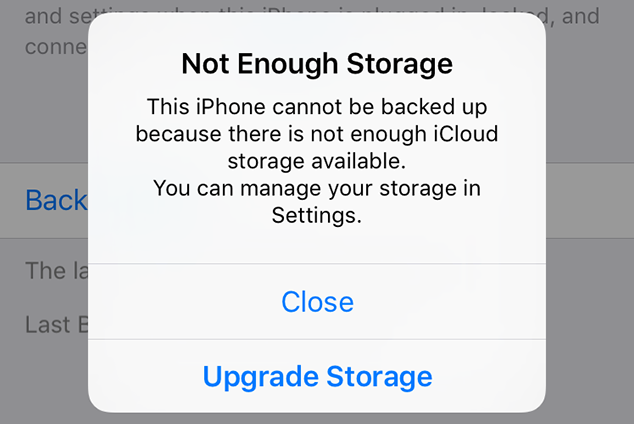Dec 13, 2017 I have plenty of space (more than enough, anyway) on my hard drive. I do not use iCloud for photo storage and did not set up iCloud when opening the new Photos app. When I try to import photos from an SD card, it says 'Insufficient Disk Space: There is not enough free space on your Photo Library volume to import the selected items. Not enough storage for El Capitan; no way to free up space. Ask Question Asked 3 years. I can open Disk Utility from this menu, and it seems logical to put some method of freeing up disk space from there, but if there is, I can't find it. What's the easiest way to free up disk space on my iMac with a huge photo library? Fusion Drive. Learn how to fix insufficient memory or disk space error in Word 2016, 2013, etc., in just 4 simple steps using Remo Repair Word software.
So, your Mac is running out of storage. You try to figure out what’s taking up your disk space by clicking the Apple logo on the top-left of the screen, selecting About This Mac, and hitting the Storage tab.
To your surprise, you see a yellow bar representing “System” that seems to occupy way more space than you think it should. In the example above, it only shows 207 GB, but take a look at this Apple discussion — some Mac users report that System Storage takes an astonishing 250 GB.
Insufficient Disk Space Error
Worse yet, you have no idea what’s included in “System” storage, because clicking the “Manage” button brings you to this System Information window… and the “System” row is greyed out.
Why does my Mac system require so much space?
What does it contain?
Is it safe to remove some of those system files?
How do I regain more storage space?
Insome cases as much as 100 times faster.Additional support classes are available for Debounced Digital andAnalog Pin, Shift Register Input/Output, and Software Serial. Most access functions are compiled to a singleinstruction and execute in 1-2 clock cycles. The library functions aremore than 10 times faster than the Arduino digital pin functions. How to instal gpio library on mac.
Questions like these may easily get to your head. Although my Mac now has a good amount of disk space available, I’m always wary of files that are taking up more space than they should.
I have no idea why “System” is greyed out while “Documents,” “System Junk,” “Trash,” etc. allow you to review the files based on size and type. My hunch is that Apple does this on purpose to prevent users from deleting system files that could lead to serious issues.
What Files Are Included in System Storage on Mac?
During my research, I found many people report that Apple counts iTunes backup files and app caches (e.g. Adobe video cache files) in the System category.
Since it’s greyed out and we are unable to click on that category for deeper analysis, we’ll have to use a third-party app to assist.
CleanMyMac X is perfect for this kind of analysis. Since I tested the app in our best Mac cleaner review, it immediately came to my head when I saw “System” was greyed out in Storage. Note that CleanMyMac isn’t freeware, but the new “Space Lens” feature is free to use and it allows you to scan your Macintosh HD, and then show you an in-depth overview of what’s taking up disk space on your Mac.
Step 1:Download CleanMyMac and install the app on your Mac. Open it, under “Space Lens” module, first click the yellow “Grant Access” button to allow the app to access your Mac files and then select “Scan” to get started.
Step 2: Soon it’ll show you a folder/file tree and you can hover your cursor over each block (i.e. a folder). There you can find more details. In this case, I clicked “System” folder to continue.
Step 3: The file breakdown below indicates that some Library and iOS Support files are the culprits.
The interesting part is that the System file size shown in CleanMyMac is much smaller than the size shown in System Information. This puzzles me and makes me believe that Apple definitely has counted some other files (not real system files) in the System category.
What are they? I have no clue, honestly. But as reported by other Mac users who experienced the same issue, they said Apple also considers app caches and iTunes backup files as System files.
Out of curiosity, I ran CleanMyMac again for a quick scan. That app found 13.92 GB in iTunes Junk. Further review revealed that the junk files are old iOS device backups, software updates, broken downloads, etc.
But even after adding this amount to the original system files returned by CleanMyMac X, the total size is still a bit less than what’s returned in System Information.
If cleaning the System Storage is still not enough to bring your Mac available disk space to a normal level (i.e. 20% or more), see below.
What Else Can I Do to Reclaim More Disk Space?
There are tons of ways out there. Here are a few of my favorites that should help you get back a decent amount of space quickly.
What can MAC do for you? The Mid-Atlantic Chapter of the Medical Library Association (MAC) is an organization of health sciences librarians and other information professionals serving the District of Columbia, Maryland, North Carolina, Virginia, Western Pennsylvania and West Virginia. The Exhibits Committee is pleased to invite you to the Annual Meeting of the Mid-Atlantic Chapter of the Medical Library Association (MAC/MLA) from October 18 – 20, 2020 at the Hotel Monaco in Pittsburgh, PA. This meeting will bring together highly engaged medical librarians and health information professionals from North Carolina, Virginia, Washington DC, Maryland, West Virginia, and Western. The Mid-Atlantic Chapter of the Medical Library Association (MAC- MLA) is an organization of health sciences librarians and other information professionals serving the District of Columbia, Maryland, North Carolina, Virginia, Western Pennsylvania, and West Virginia. Mac mla library database.
1. Sort all files by size and delete old large files.
Open Finder, go to Recents and look at the Size column. Click on it to sort all recent files by file size (from large to small). You’ll have a clear overview of what items are eating up a large amount of space, e.g. From 1 GB to 10 GB, and from 100 MB to 1 GB.
On my MacBook Pro, I found a few large videos that could be transferred to an external drive.

Note: If the Size column doesn’t show up, click on the Settings icon and select Arrange By > Size.
2. Remove duplicate files.
Don’t forget those duplicates and similar files! They can stack up without you being aware of it. Finding them is sometimes time-consuming. That’s what Gemini 2 is designed for. Simply select a few frequently used folders (e.g. Documents, Downloads, etc.) in the main zone of Gemini.
It then scans them and returns all the duplicate files that might be worth removing. Of course, it’s always a good practice to review them before doing so. You can also read more from our detailed Gemini review here.
Mar 18, 2020 Move a library to an external storage device. Select your external drive in the Finder, then choose File Get Info. If the information in Sharing & Permissions isn’t visible, click the triangle, then make sure the 'Ignore ownership on this volume' checkbox is. Click your desktop to. If the media in a movie, a trailer, or an event is located outside your iMovie library, you can consolidate all the media in one location (either on your Mac or on a connected storage device) by copying the media to your iMovie library. An iMovie library holds all the media and data used to make movies in iMovie. If your iMovie library is large and you want to free up storage space on your Mac, you can move your iMovie library to an external drive. Before you move an iMovie library, it's a good idea to back up your Mac. Is imovie only for mac.
Wrapping It Up
Ever since Apple introduced the Optimized Storage feature, Mac users got the option of saving space by storing content in the cloud. Apple also has several new tools that make it easy to find and remove unneeded files.

Mac Disk Space Management
That bar under the Storage tab is beautiful. It does allow you to get a quick overview of what’s taking up the most space on our hard drive. However, it still lacks insights into the “System” category as it’s greyed out.
Insufficient Disk Space Nox Player
Hopefully, the guides above have helped you figure out the reasons you’ve got so much “System” data, and most importantly you’ve reclaimed some disk space — especially for new MacBooks pre-installed with flash storage — every gigabyte is precious!